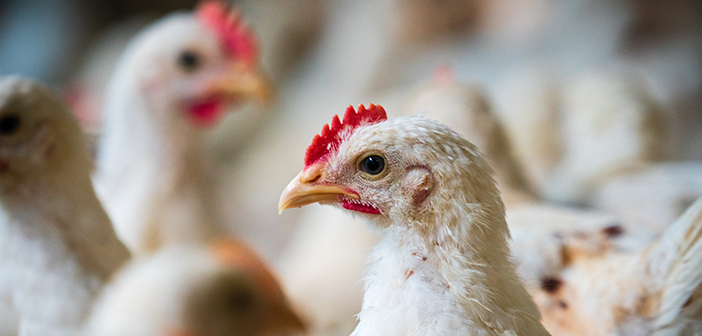Motivating broiler chickens to move using specially designed lasers can boost animal welfare, according to new research.
Research from Iowa State University shows periodically projecting randomly moving, dot-sized laser lights on the floor of broiler pens stimulates birds’ predatory instincts and encourages them to be more active. This can be of especially beneficial as broilers approach market weight and become more sedentary.
Elizabeth Bobeck, associate professor of animal science, and Anna Johnson, professor of animal behaviour and welfare, partnered with Signify, a livestock lighting company, to create a laser device for this research. With support from the U.S. Poultry and Egg Association, USDA and its National Institute of Food and Agriculture, they conducted a study to assess how these devices influence animal behaviour.
“We were concerned the birds would exercise more, be smaller and lose weight,” Bobeck said. “Instead, we found that they spent more time walking around and engaging in more positive behaviours that improved weight gain and bone density.”
Broilers exposed to the lasers walked more frequently and for longer distances than their counterparts in the control group. They also spent more time at feeders and drinkers, thus gaining more weight and improving their feed efficiency. Despite their increased activity, birds in the treatment group did not experience more lesions, scratches or blisters on their feet or bodies.
Bobeck and Johnson conducted subsequent studies to measure different aspects of broiler performance, meat quality and stress in response to this biologically relevant environmental enrichment from lasers. In one experiment, they found the level of serum corticosterone, a stress hormone, in broilers’ blood was actually lower when birds were exposed to the laser devices.
“We wanted to know if the laser was used, does it make the birds more anxious or frightened? The answer was no,” Johnson said. “One thing we were mindful about when creating the lasers is allowing the individual bird choice. If the broilers want to interact with the laser, they can; if they choose not to, they can do that, too. I think that is a real benefit from a welfare standpoint.”
The size and movement of the novel laser devices mimics small insects that chickens naturally want to chase. The lasers emit a red light to attract the birds’ attention and ensure animal and human safety.
“We picked red because we knew it would be an enticing colour for broilers, but also from a safety perspective,” Bobeck said. “Other laser colours, like green, have a more intense wavelength and can be more damaging to eyes.”
Over 30 undergraduate students and several graduate students have been involved with the laser device research at Iowa State. The lasers are currently undergoing research trials at a commercial confinement to understand their utility at large operations. Bobeck and Johnson believe this type of environmental enrichment can also benefit smaller flocks, as well as other types of poultry, such as turkeys and laying hens.


